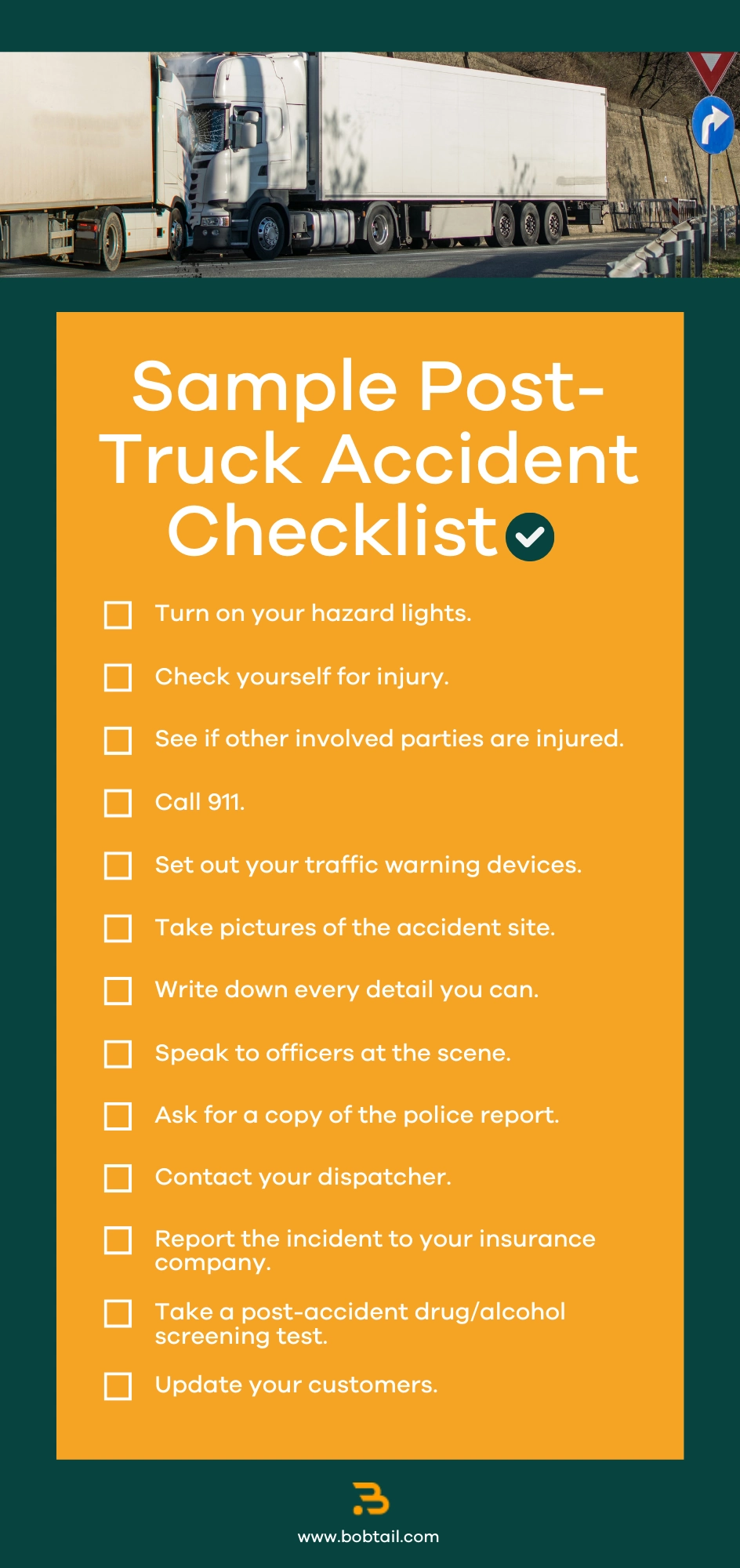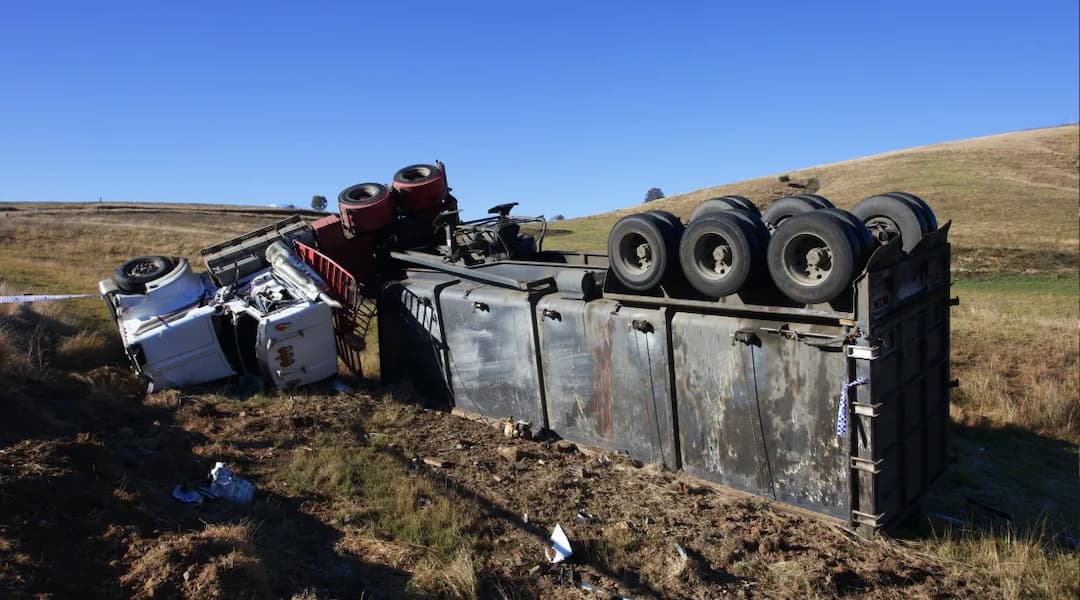After A Semi Truck Accident, Here’s What To Do
It’s an unfortunate fact of the industry, but semi truck accidents happen. Combination trucks like semis were involved in property-damaging crashes at least 167,000 times in 2020 alone—and some trucking accidents lead to much worse outcomes than property damage alone.
Accidents involving large trucks led to nearly 5,000 deaths and almost 70,000 injuries in 2020. (Those numbers went up to 5,417 deaths and 79,860 injuries the following year; the Federal Motor Carrier Safety Administration [FMCSA] is still collating data for 2022.)
Even when wrecks don’t hurt anyone, they can be very expensive. The FMCSA estimated that the total cost for commercial vehicle crashes was $143 billion in 2020. In other words, one incident could bankrupt a carrier—and costs tend to rise as drivers make mistakes at the accident scene.
We asked a small-fleet owner about his experience handling on-the-road incidents, and he summed up the general opinion:
“It’s definitely not something that is fun to deal with,” one fleet owner said.
Fun or not, you stand a much better chance of limiting your liability if you know what to do when a semi accident occurs. Every trucking company must set procedures for drivers to follow after an incident. Not sure what that procedure should look like? This article is a great place to start.
Nothing on this page is legal advice, of course, but we hope it gives you some ideas for your own post-accident procedures.
A Sample Post-Truck Accident Checklist

Here’s a step-by-step checklist of important things drivers should do after a semi accident. Throughout these steps, it’s most helpful to stay calm. That’s easier said than done, but try to slow down, take deep breaths, and think before you do any of the following:
1. Turn on your hazard lights.
Any time you stop on a highway, you are required to turn on your warning flashers. (That’s according to FMCSA regulations.) Since flashers only take a split second to activate—and they reduce the risk of more accidents—it’s safest to turn them on every time you stop unexpectedly, especially during accidents.
2. Check yourself for injury.
Are you sure you’re alright? If you need medical attention, call 911 immediately—or ask for someone else at the scene to make the call. You can’t proceed down this checklist if you’re not healthy enough to take action.
3. See if other involved parties are injured.
If it’s safe, run a general health check for other drivers and passengers involved in the incident. Do this with your phone in hand. That way you’ll be able to describe the situation to a 911 dispatcher. Don’t try to move anyone unless they’re in immediate risk (e.g., in the line of encroaching flames or downed electrical lines). In 99.9% of situations, the best move is to wait for paramedics.
4. Call 911.
Even if everyone’s okay—and even if the accident seems vanishingly minor—get first responders to the scene. You may not feel like you need police or an ambulance, but your insurance company and legal team will absolutely need a police report. In short: call 911 no matter what.
5. Set out your traffic warning devices.
The FMCSA requires you to carry at least three reflective traffic triangles (or similar warning devices like flares). Now’s the time to use them. While you may be tempted to clear the roadway, don’t do so until the authorities arrive and give the order.
Traffic triangles will reduce the risk of further calamity in the meantime; just make sure to place them according to FMCSA standards as listed in CFR 49 392.22 (b)(1). That is, place one triangle in each of these three places:
- On the traffic side, four paces from the truck toward the approaching lanes;
- 40 paces from the truck in the middle of the lane, and;
- 40 paces from the truck in the other direction.
6. Take pictures of the accident site.
If the scene is unsafe in any way, wait for authorities before starting your own documentation. If it’s safe, however, start taking pictures. Get shots from every angle, close-up and from a distance. Take pictures or video of tire marks, crash debris, and nearby traffic signs. If another vehicle is involved, get a picture of the license plate.
7. Write down every detail you can.
Later, once the scene is cleared, you’ll need to write a detailed report. Start taking notes now, while the incident remains fresh. Jot down:
- What happened from your perspective
- Environmental conditions at the time of the incident (i.e., lighting, weather, and road condition)
- Any and all property damage you observe
- Injuries to yourself and others
- Identifying information about responding officials (i.e., police departments, police car numbers, officer badge numbers, tow truck companies, emergency medical providers, etc.)
- Identifying information about other vehicles involved (i.e., license plate number, make, model, color)
- Names and contact information for witnesses
- Identifying information about other drivers involved (i.e., name, means of contact, insurance company, insurance policy number)
Note: It’s usually safest to let officers collect names and contact information from any other involved parties. It’s okay to ask politely for this information. If someone refuses to give a name or insurance policy number, that’s okay; let the police handle it. Whatever you do, don’t get into an argument. (See boxed text for more tips on what to avoid at an accident scene.)
8. Speak to officers at the scene.
Once police show up, they’re in charge of the accident scene. Follow directions and answer all questions—but limit your speaking to answering the officer’s questions. Answer truthfully and fully, but don’t veer from the subject. You don’t want to accidentally incriminate yourself.
9. Ask for a copy of the police report.
Insurers and/or legal teams probably need names, contact information, and insurance details for anyone else involved in the incident. Those details should be in the police report. Send this report (along with your telling of events and documentation photos) to your office, if you have an office. If not, save all this documentation for your insurance company or a future legal case.
10. Contact your dispatcher.
If you’re an owner-operator and you use a dispatching service, contact your assigned dispatcher. Dispatchers may be able to walk you through important steps following a truck driver accident or any similar incident.
If you’re a company driver, follow protocols (they should have been covered in training). Many companies will ask you to notify your dispatcher before taking many of the previous steps. Whether you’re an owner-operator or a company driver, dispatchers can update shippers, brokers, and other related parties. That’s an important part of responding to an accident.
11. Report the incident to your insurance company.
Company drivers may not have to deal with insurance companies; it might be enough to talk with your dispatcher. But if you handle your own commercial trucking insurance policies, don’t forget to make a report as soon as possible following an incident.
12. Take a post-accident drug/alcohol screening test.
The FMCSA requires drug-and-alcohol tests following most types of accidents. If a driver gets cited following an accident, this test is required. It’s also mandatory for all incidents leading to fatality. These tests must be administered “as soon as practicable.”
But regardless of FMCSA requirements, our fleet-owner source recommends testing after every incident. It’s a good way to protect against spurious lawsuits.
“If the opposing party wants to open a claim, the legal action will start with one question: Did you take a drug test?” said the fleet owner. “If you say no, you might as well just hand over a check.”
To register with the FMCSA Drug & Alcohol Clearinghouse, you should have already signed up with a third-party testing provider. Contact that provider to get tested (or to get the driver who was involved tested).
13. Update your customers.
If you’re a company driver, you probably only have one point of contact. That’s your dispatcher. Office staff will update brokers, shippers, and receivers on load status. If you’re an owner-operator, however, don’t forget to give your customers the bad news. If the shipment is damaged, they’ll file an insurance claim. If the shipment’s merely delayed, your broker may arrange for another truck to pick it up. None of that gets started until you notify the appropriate parties.
What NOT To Do After A Semi Truck Accident |
|---|
It’s easy to make a mistake at an accident scene. Emotions run high. But say or do the wrong thing, and you may end up paying a legal price down the road. Here are a few things truck drivers should always avoid after an incident:
|
Maintaining Cash Flow For Truck Accident Costs
Even if you do everything by the book, a semi truck accident will probably lead to unplanned expenses. That could be a challenge in an industry where customers take weeks or months to pay invoices. If you find yourself with surprise cash needs, get same-day funding on your invoices with factoring from Bobtail.
We’ll pay you today so you can keep driving tomorrow. Try factoring with Bobtail.




